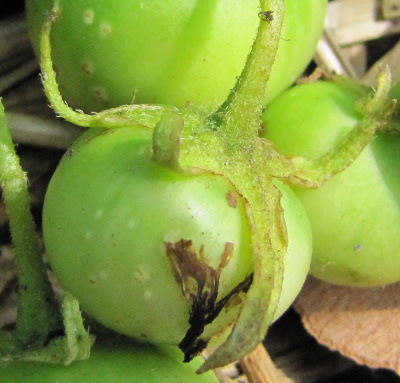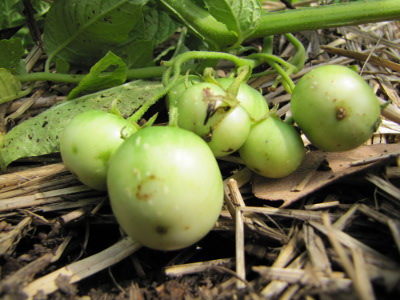
Potato fruits and growing potatoes from seed
 As
I weeded the potato beds, I stumbled across these little green fruits
nestled amid the foliage. No one seems to know why potato blooms
wither most years then develop into fruits every once in a while, but I
can attest that this is the first time in five years of growing
potatoes that I saw any fruits. I planted my potatoes very late
this year so that they'd store better, which might have had something
to do with it. Extension service websites also report that some
varieties (like the Yukon Golds I'm growing) fruit more often than
others.
As
I weeded the potato beds, I stumbled across these little green fruits
nestled amid the foliage. No one seems to know why potato blooms
wither most years then develop into fruits every once in a while, but I
can attest that this is the first time in five years of growing
potatoes that I saw any fruits. I planted my potatoes very late
this year so that they'd store better, which might have had something
to do with it. Extension service websites also report that some
varieties (like the Yukon Golds I'm growing) fruit more often than
others.
Potato fruits are
poisonous, but if you let them ripen, you can save the seeds the same
way you save
tomato seeds.
The goal isn't really to get more potatoes --- cloning the tubers is by
far the most efficient method of growing potatoes. Instead,
starting potatoes from seed is a way of playing the garden lottery,
producing lots of new varieties that might just possibly be better than
their parents.
 Extensive searching of the
internet turns up only a few people who have actually committed the
time and space to grow potatoes from seed, and from what they report,
the project sounds like a lengthy undertaking. If I saved these
seeds in 2011, I'd plant them in early 2012 and end up with tiny tubers
no more than an inch in diameter. Save those tubers and use them
as seed potatoes in 2013, and I'd finally grow potatoes large enough to
taste and test. Although the garden geek in me is itching to give
it a try, I don't think we care enough about potatoes to allot that
much space and energy to the experiment.
Extensive searching of the
internet turns up only a few people who have actually committed the
time and space to grow potatoes from seed, and from what they report,
the project sounds like a lengthy undertaking. If I saved these
seeds in 2011, I'd plant them in early 2012 and end up with tiny tubers
no more than an inch in diameter. Save those tubers and use them
as seed potatoes in 2013, and I'd finally grow potatoes large enough to
taste and test. Although the garden geek in me is itching to give
it a try, I don't think we care enough about potatoes to allot that
much space and energy to the experiment.
Want more in-depth information? Browse through our books.
Or explore more posts by date or by subject.
About us: Anna Hess and Mark Hamilton spent over a decade living self-sufficiently in the mountains of Virginia before moving north to start over from scratch in the foothills of Ohio. They've experimented with permaculture, no-till gardening, trailersteading, home-based microbusinesses and much more, writing about their adventures in both blogs and books.
Want to be notified when new comments are posted on this page? Click on the RSS button after you add a comment to subscribe to the comment feed, or simply check the box beside "email replies to me" while writing your comment.

Many folks, when they see a list of 'night shades' play the "which one of these, is not like the other" game. These fruit are the missing link. They look like mini green tomatoes and especially so if you cut them open.
I'm with you, I'd like to play with the genetics and try to create something new. Maybe try to get a cross between some of the larger 'taters and some of the fingerlings (which I think have superior flavor). However, it is a long process and I don't have a really good place to store them over winter.
Pat in MO
Everett --- It could just be that Yukon Gold is the most likely to fruit of the conventionally grown potatoes, but that heirloom varieties are even more prone to it. I can see how breeders would select against potatoes that bore fruit just like industrial egg layers have been bred not to go broody, both for efficiency reasons.
Pat --- While researching potato fruits, I found out that potatoes and tomatoes are similar enough that you can graft them together, and there's even a variety that you can grow from seed that has tomatoes aboveground and potatoes below. But both of those options seem to be novelties --- yields are supposed to be low.
Last year (2010) I grew Maris Piper variety and deliberately left some to flower and fruit, until about end of October. When these green "fruits" were about an inch across I took them off the plants and kept them in the kitchen till around early February.
I then split them open and carefully placed the pieces into a coffee filter paper inside a large mug and poured warm water onto them and seperated the seed from the pieces of green fruit. At this stage the seed is like DUST, leave everything inside the filter paper but carefully remove from the mug allowing the water to drain, as if it were coffee brewing. Fold over the filter paper so as not to lose anything from inside, place on kitchen towel or similar and allow to dry naturally but thoroughly.
When dry, I removed the fruit particles leaving the "dust".
The potato "SEED" was planted in large containers around early summer (mid May) and at the moment (1st of November 2011) I do not know if I should "lift" the potatoes and see what size and how many "seed potatoes" I have for next year OR do I sit a little longer. Patience is a virtue apparently.